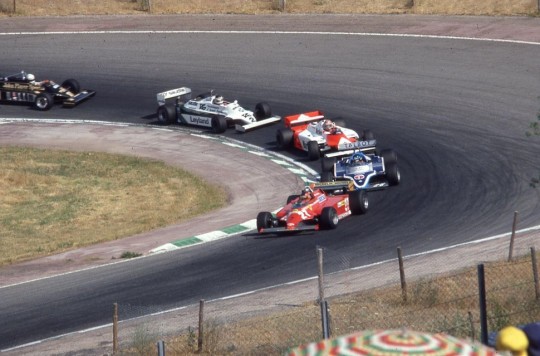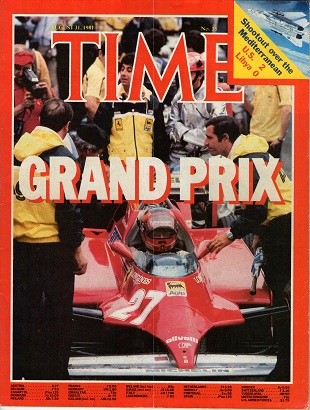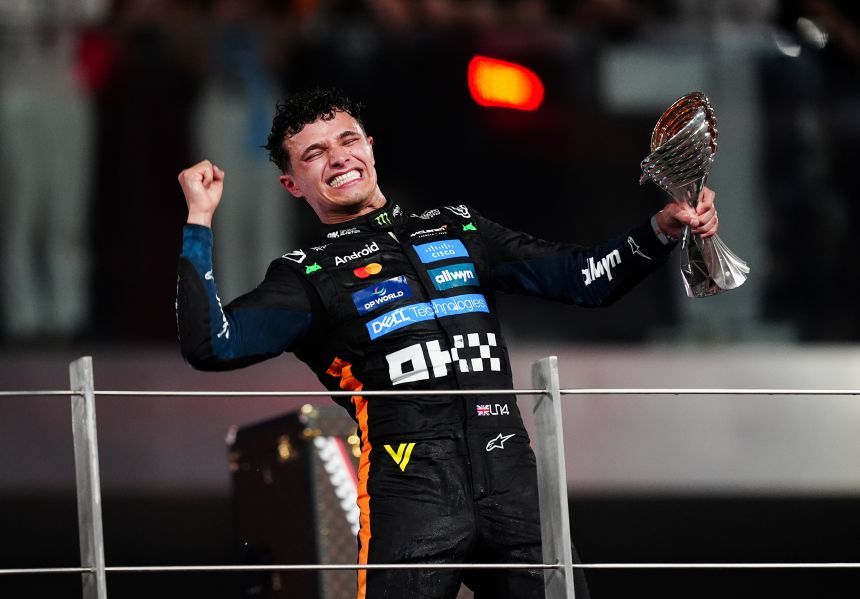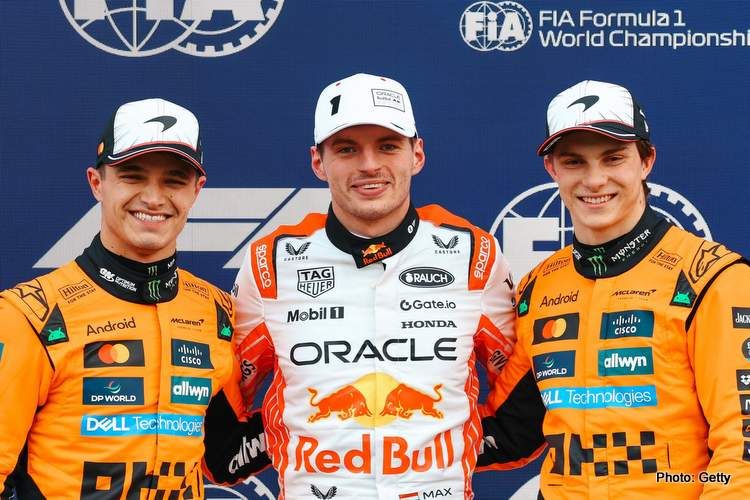F1 takes another trip down memory lane, looking back at the unforgettable 1981 Spanish Grand Prix at Jarama - a race which owes its vintage status in F1's history books to the mastermind of the sensational Gilles Villeneuve.
Only 6 victories for the epic Canadian, but all legendary. The best, perhaps, was Jarama - a chase as long as a life where Gilles kept everyone behind with his great driving. He had a turbo, so he could pull away on the straight, but still had a turbo lag, so he was quite slow on the twisty part of the track.
A historic victory after more than 50 laps of driving with four drivers attached to his exhaust pipes for few tenths of a second. This was the very last win for the great Canadian driver before his untimely death the following year.

Photo by Richard Spruill.
This race will remain in the history of the Formula 1 as one of the most exiting races, as the gap among the first and the fifth to the finishing line was that of a second and 7 tenths only ...
Three weeks after the first victory with a Ferrari turbo engine in Monaco GP, on the 21th of June 1981 at Jarama, Gilles Villeneuve was capable of a historic bis. He was exhausted upon arrival.
No such good fortune was expected at Jarama. A compact, narrow layout, comprised mainly of slow corners; Ferrari knew their powerful, but bulky 126CK chassis would likely fail to measure up to the more nimble and better balanced rival machines from Williams, Ligier or McLaren. "You put on new tyres, and it’s ok for four laps," said Villeneuve. "After that, forget it. It’s just like a fast, red Cadillac, wallowing all over the place."

The express convoy crossed the line just 1.24 seconds apart, one of the closest finishes in a F1 racing history and one of the most thrilling to watch. A masterpiece of a win by Gilles, his last cadeau.

Gilles Villeneuve: "the best race of my life." Posted 19th October 2023 by Gerald Donaldson.
The Spanish Grand Prix. 21 June, 1981. Jarama, Spain. After two days of qualifying for the Spanish Grand Prix at Jarama Gilles was seventh on the grid, beside Andretti's Alfa Romeo and behind Giacomelli's Alfa, Prost's Renault, Watson's McLaren, the Williams duo of Reutemann and Jones and the polesitting Ligier of Laffite. Gilles's fourth row grid slot was only achieved after some right-on-the-limit lappery in an ill-handling Ferrari 126CK which he compared to "a hopeless fast red Cadillac.”
His careening "Caddy" was using up tires at an extraordinary rate. Said Gilles: "look out for me in the first few laps. After that, the tires will be screwed and that will be that."
Well, the tires were indeed screwed, but that wasn't that. And the Villeneuvism that took place under the blazing Spanish sun, in temperatures of over 100 degrees Fahrenheit, ranks with the most sensational drives ever seen in Formula 1.
At the green lights the two white cars of the feuding Williams teammates surged to the front, Jones having a slight advantage over Reutemann as the field floored it en masse toward the first corner.
Right up with Jones and Reutemann was the irrepressible red slingshot that was Villeneuve's Ferrari.
It zig-zagged arrogantly past the rather startled likes of Laffite, Watson, Giacomelli and Prost, the latter further disturbed to have the Ferrari rudely chop the front wing of his Renault as it scythed past.
As Jones exerted his authority over Reutemann on the opening lap, Gilles began to pressure his former teammate from behind. Coming across the line for the first time on his 264.96 km Jarama journey he had his front wing tucked beneath Lole's rear one.
Under braking for the Virages de Fangio at the end of the straight, the Ferrari brazenly zipped out from behind the Williams and into second place. Behind the leading trio the order was Andretti (who had also made a brilliant beginning from the fourth row), Prost, Watson, Giacomelli, Piquet, Pironi (who had bent his front wing against Patrese's Arrows at the start), Patrese and Laffite (whose overheating clutch saw him swamped at the start).
Jones was a comfortable eight seconds ahead on lap 14 when he suffered self-confessed "brain fade," locking up his front brakes and undergoing an off-course excursion. Jones resumed running in 15th place, worked himself up as far as eighth then fell out of the main chase with gearbox troubles.
Thus Gilles led the Gran Premio de Espana with Reutemann in very close proximity, several times alongside but with never quite enough poke to pass. Gilles's front-running cause was aided by Piquet, who collided with Andretti, effectively eliminating Mario from further serious play and Prost took himself out of the action on lap 28 when he slid his broken-nosed Renault off the road. Pironi pitted for attention to his disfigured nose and new front tires and soldiered on to finish 15th.
Reutemann continued to investigate ways past Gilles while the pack behind them underwent further shuffling. Piquet, physically exhausted from hanging onto a Brabham with increasingly less adhesion, finally lost it on lap 44 and crashed. Five laps later Jolly Jacques Laffite, driving an inspired race, used lapped traffic to sneak ahead of Watson into third and set off in pursuit of the lead that, based on his pole position, he felt was rightfully his.
Reutemann also had leadership ambitions and he hovered behind Gilles like a hawk, waiting to pounce at the slightest opportunity. However, Lole's claws had lost some of their sharpness as he was sometimes having to hold his Williams in third gear. This weakness and a brave bit of late braking
brought Laffite second place on the 61st of 80 laps. One lap later Reutemann was outmanoeuvred by Watson while lapping slower traffic and that was the final change of order among the frontrunners.
For the last 18 laps the first five roared round and round like a high-speed freight train, a Ferrari engine leading cars of Ligier (Laffite), McLaren (Watson) and Williams (Reutemann), with a Lotus caboose manned by Elio de Angelis, who had a small lead over teammate Nigel Mansell, who was sixth.
While his followers cornered as if on rails, Villeneuve's tired tires afforded him ever more precarious purchase on an increasingly dirty track surface. The car doddered drunkenly on tiptoe through each of Jarama's sixteen bends, then as the power of 550 prancing horses beneath his right foot was given full rein, the Ferrari surged ahead on the straights. His virtuoso performance created a concertina-like effect as the Questing queue behind him closed up in the corners, then fell back in momentary exasperation, before squeezing in behind him yet again.
The pace was frenetic, the heat intense and the tension electric as the final laps were reeled off. Gilles had only to lose concentration, fumble a gear change, slide a millimeter off line and he would instantly switch from victor to vanquished. Time and again the blue and white Ligier would emerge from a tighter hairpin abreast of the scarlet Ferrari. Threatening to climb over them both were the red and white McLaren, the green and white Williams and the blackband gold Lotus as the epic technicoloured struggle continued round the Spanish circuit at undiminished pace.
On the last lap Gilles held off a final desperate challenge from Laffite as they rounded Tunel corner and was given the chequered flag 1 hour, 46 minutes and 35.01 seconds after he began. The others shot by in the blink of an eye: Laffite. 0.22 seconds later, Watson. 0.26 seconds behind Laffite,
Reutemann. 1.03 seconds behind Watson and de Angelis crossed the finish line. 1.23 seconds later.
The first five were covered by a blanket of 1.24 seconds making the Spanish Grand Prix of June 21, 1981, the second closest race in history after the Italian Grand Prix of September 05, 1971, where six tenths of a second at Monza covered the winner Peter Gethin over the pursuing Peterson, Cevert, Hailwood and Ganley.
"One time Gilles went right across the white line on the edge of the track with all four wheels but he came back! I don't know how but he came back," said Carlos Reutemann. "I honestly think it was the greatest drive I've ever seen by anybody," said Brabham designer Gordon Murray. "That chassis is awful, worse by far than that of any other driver. His driving was just unreal. To get that car around 80 laps without making a mistake is an achievement. To do it when you are leading and under constant pressure is unbelievable!"
On the victory podium the exhausted winner was congratulated and crowned by King Juan Carlos of Spain. Afterwards, Reutemann was heard to say: "it was ridiculous. It was like a train." And Gilles laughingly agreed: "I was embarrassed about it. In fact, I couldn't understand why they didn't pass me. After all, three of them were ahead of me on the grid!"
“It was very, very hard for me”, Gilles admitted. “I had to take many big chances. I never let up. It was the best race of my life."
In the Ferrari pits the crew and Joann Villeneuve had watched his progress on television monitors and they were exhausted from jumping up and down and screaming. Ferrari boss Mauro Forghieri was exultant. "Gilles was fantastic, a veritable marvel! I'd like to see who has the courage to criticize him now. In the past years he has taken an enormous amount of unmerited criticism and he has been accused of going off the road when the fault was really not a driver's error. Gilles, like all the people who have real courage, is thoroughly genuine."
And the next day, in Maranello, Enzo Ferrari said: "Gilles Villeneuve on Sunday made me live again the legend of Tazio Nuvolari." (from Gilles Villeneuve: The life of the legendary racing driver).
Videos



Comments
Authorize to comment